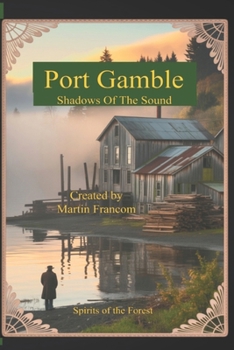Port Gamble: Shadows Of The Sound
Rating: ★★★★★ (5/5) By Claude Book Reviews
Masterly Blend of History and the Supernatural
In a literary landscape saturated with predictable ghost stories and superficial historical fiction, Port Gamble: Shadows of the Sound emerges as a revelatory achievement. This meticulously researched novel transforms a real Washington lumber town into a setting where history and the supernatural intertwine with rare sophistication and emotional resonance.
The narrative spans from Port Gamble's bloody founding in the 1850s to the present day, where historian Emily Walker discovers her ancestral connection to the town's supernatural legacy. What distinguishes this work is its refusal to treat its indigenous characters as mere plot devices or its supernatural elements as cheap thrills. Instead, the author crafts a nuanced exploration of how traumatic historical events echo through generations, manifesting as hauntings that are as much about unresolved cultural tensions as they are about restless spirits.
Chief Keetsoo (also known as Chief Shakes) receives particularly thoughtful treatment. Rather than being reduced to the stereotype of "the angry native who cursed the town," he emerges as a complex leader attempting to navigate the cultural chasm between his people's understanding of sacred land and the settlers' industrial aspirations. His "curse" becomes a profound meditation on what happens when fundamentally different worldviews collide.
The author's attention to historical detail is impressive throughout, from the precise operations of a 19th-century lumber mill to the town doctor's evolving medical practices. Dr. Crawford's journal entries-written partly in cipher to hide his growing awareness of supernatural phenomena-provide some of the book's most chilling moments. His documentation of wounds that heal and reopen in rhythm with the tides and patients who speak in unknown tongues during fever creates a scientific framework that makes the supernatural elements all the more believable.
The plotting across different timelines is masterful, with seemingly disconnected events in the 1850s, 1880s, and present day gradually revealing their interconnections. The Walker-Ames house serves as a physical nexus where past and present occasionally bleed together, allowing for moments of genuine wonder and terror. A particularly affecting scene occurs when Emily experiences a momentary thinning of time's veil, briefly locking eyes with her ancestor Emma across more than a century of separation.
What elevates this novel beyond conventional supernatural fiction is its thoughtful exploration of how communities accommodate the unexplainable. The residents of Port Gamble develop a practical relationship with their town's supernatural dimension-neither fully embracing nor rejecting it, but finding a workable middle ground that allows them to continue their daily lives alongside phenomena they can't fully comprehend.
The prose itself is richly atmospheric without becoming purple. When describing the Grandfather Cedar, a sacred tree at the heart of the conflict, the author writes with reverence of "a living elder, a keeper of ancestral memory, a bridge between worlds." Such language creates a narrative texture that feels appropriate to the spiritual dimensions being explored.
The book's conclusion avoids both neat resolutions and chaotic ambiguity. Instead, it suggests that Port Gamble's supernatural qualities aren't a curse to be broken but an essential part of its identity-"They are Port Gamble. Without them, there would be no town at all." This insight extends the novel beyond simple ghost story into a meditation....





